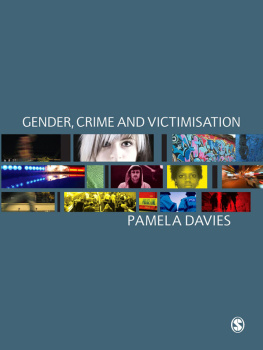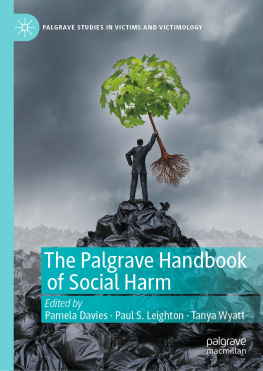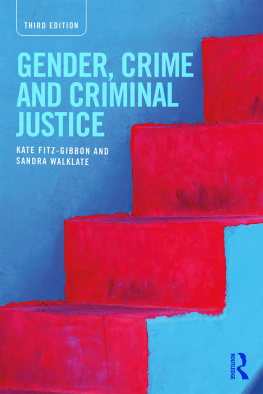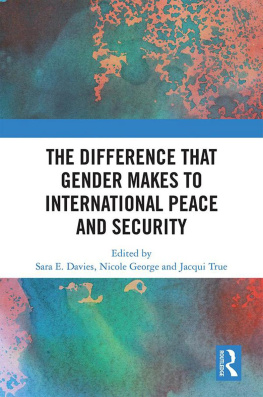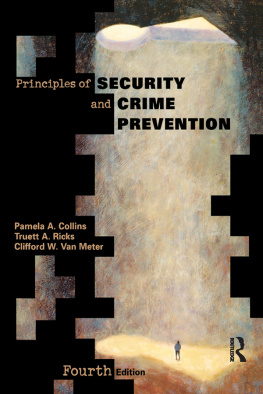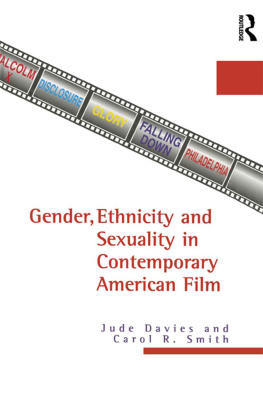Gender, Crime and Victimisation
Gender, Crime and Victimisation
Pamela Davies
Pamela Davies 2011
First published 2011
Apart from any fair dealing for the purposes of research or private study, or criticism or review, as permitted under the Copyright, Designs and Patents Act, 1988, this publication may be reproduced, stored or transmitted in any form, or by any means, only with the prior permission in writing of the publishers, or in the case of reprographic reproduction, in accordance with the terms of licences issued by the Copyright Licensing Agency. Enquiries concerning reproduction outside those terms should be sent to the publishers.
SAGE Publications Ltd
1 Olivers Yard
55 City Road
London EC1Y 1SP
SAGE Publications Inc.
2455 Teller Road
Thousand Oaks, California 91320
SAGE Publications India Pvt Ltd
B 1/I 1 Mohan Cooperative Industrial Area
Mathura Road
New Delhi 110 044
SAGE Publications Asia-Pacific Pte Ltd
33 Pekin Street #02-01
Far East Square
Singapore 048763
Library of Congress Control Number: 2010924434
British Library Cataloguing in Publication data
A catalogue record for this book is available from the British Library
ISBN 978-1-84787-027-8
ISBN 978-1-84787-028-5
Typeset by C&M Digitals (P) Ltd, Chennai, India
Printed by MPG Books Group, Bodmin, Cornwall
Printed on paper from sustainable resources
Contents
List of Figures
List of Tables
List of Boxes
Acknowledgements
I would like to thank several people who have encouraged me in the writing of this book. In particular, my colleague Peter Francis stands out for his unwavering support and for the valued wisdoms he has shared with me over the last 17 years. Hazel Croall, Barbara Hudson and Mary Mellor have also been inspirations to me and friends along the way. These and other colleagues, too numerous to mention, in criminology and sociology who must surely have been wondering what exactly I have been doing much of the time deserve to see a final product! I also owe a debt of gratitude to students who have debated many of the issues that appear throughout this book and who have done much to shape its content. Thanks are also due to the editorial team at Sage, Caroline Porter and Sarah-Jayne Boyd for their patience and support of this book.
Finally, thanks to my parents Joyce and Bill, my husband Damian and our children, Rory, Callum and Jonathan without whom I would never remain sane.
THE GENDER AGENDA TO CRIME AND VICTIMISATION
CONTENTS
- Chapter aims
- Introduction
- Glossary
- The scope of this book
- Key foci for the book
- Crime, victimisation/social division nexus
- Gender salience?
- A gender agenda?
- Gender and gender dichotomies
- Case study: women and crime for economic gain
- The structure and layout of this book
- Study questions
- Suggestions for further reading
GLOSSARY TERMS
Primary victimisation
Tertiary victimisation
Indirect victimisation
Victimology
Gender
Sex
Feminism
Crime victim
Masculinity
Gender-neutral
Gender-free
Gender myopia Gender-blindness
Gender-bias
Gender specificity
Doing-gender
Doing-difference
CHAPTER AIMS
- Outline the parameters and the major frames of reference for the book
- Specify the aims and objectives of the book
- Establish the benchmarks for exploring gender, crime and victimisation
- Introduce the key research, theory and policy agendas
Introduction
Students of criminology and related disciplines can now be pointed towards a growing body of authoritative texts that feature the word gender in their titles. Words in addition to gender such as crime, criminal justice, violence and imprisonment are connected in titles belonging to several of the more criminologically focussed publications. The title and content of this book is therefore original and different from any of these in that it connects the word gender to both of the additional words, crime and victimisation. The latter constitute the two major frames of reference for this books gendered journey.
Within one frame of reference, gender and crime a detailed examination of gender patterns to offending and more broadly to the committing of crime are examined. How these patterns are variously established and represented, researched, explained, theorised and responded to by policy makers and criminal justice intervention methods are all examined through a gendered lens. Within the other frame of reference, gender and victimisation is a detailed examination of gender patterns to victimisation including criminal victimisation, primary, tertiary and indirect victimisation and other forms of social harm. How these patternings of victimisations in society are variously established and represented, researched, explained, theorised and responded to by policy makers, criminal justice and other intervention strategies and support networks are simultaneously examined through a gendered lens. Using these two major frames of reference, which are given roughly equal weight, this book explores a comprehensive range of gender issues in the study of crime and victimisation.
The remainder of this introductory chapter outlines the scope, aims and objectives of this book. It includes a preliminary discussion on the gender agenda to crime and victimisation drawing on key developments within the discipline of criminology and its sub-discipline as there is confusion evident in some criminological and victimological literature. This clarification of meaning is best achieved by reference to what gender does not mean as well as what it does mean.
The most appropriate way to explain how gender is commonly used throughout this book is to refer to it as a sociological term where there is specific distinction between sex and gender. The word gender is sometimes inappropriately used as a substitute for the word and this changes the original meaning. To clarify the sex/gender confusion Walklates observation is useful: sex differences, i.e. differences that can be observed between the biological categories, male and female: they are not necessarily a product of gender. Gender differences are those that result from the socially ascribed roles of being male or being female, i.e. masculinity and femininity (Walklate, 2004: 94).
When teaching these terms the following simple schema helps not only clarify but also complicate our understanding of gender:
| SEX | GENDER |
| Male/Female | Masculine/Feminine |
This simple schema raises oppositional associations of male/female and of masculine and feminine. These are often referred to as gender dichotomies and a number of these are illustrated later in this introductory chapter.
Glossary
Above you will have noted how some words/terms/concepts for example primary, tertiary and indirect victimisation, victimology and gender, have been highlighted in bold. When you see emboldened terms like this you should refer to the comprehensive glossary at the end of the book. There these terms are listed in alphabetical order and a succinct meaning of each is provided.



